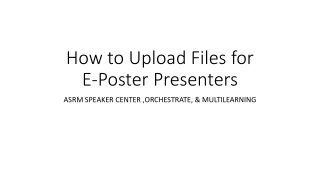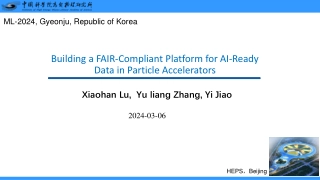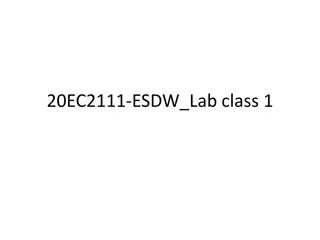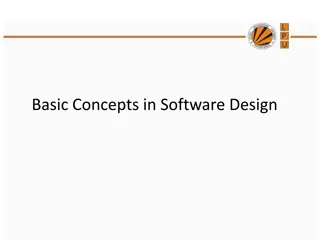Design and Implementation of IO Framework for HEPS Speaker
This project focuses on designing and implementing the IO Framework for HEPS Speaker, aiming to optimize I/O processes for batch and stream processing, address data volume challenges, and accelerate scientific processing in High Energy Photon Source applications.
Download Presentation

Please find below an Image/Link to download the presentation.
The content on the website is provided AS IS for your information and personal use only. It may not be sold, licensed, or shared on other websites without obtaining consent from the author.If you encounter any issues during the download, it is possible that the publisher has removed the file from their server.
You are allowed to download the files provided on this website for personal or commercial use, subject to the condition that they are used lawfully. All files are the property of their respective owners.
The content on the website is provided AS IS for your information and personal use only. It may not be sold, licensed, or shared on other websites without obtaining consent from the author.
E N D
Presentation Transcript
Design and implementation of the IO Framework for HEPS Speaker: Fu Shiyuan IHEP computing center, postdoctoral <fusy@ihep.ac.cn>
Outlines 1. Introduction 2. Unified I/O interface 3. Optimization for batch processing 4. Stream processing 5. Conclusion 3
Introduction for HEPS HEPS High Energy Photon Source Include multi beamline HEPS will generate a huge mount of data In which the data volume generated by B7 is the most The huge mount of data will give great pressure to storage and computing 300 Data Volume 250 (TB/Day) 200 150 100 50 0 beamline B1 B2 B3 B4 B5 B6 B7 B8 B9 BA BB BC BD BE BF 4
Introduction for HEPS Design and implement HEPS I/O optimization methods, and integrate them with Daisy[1]. To address the diverse applications of HEPS, shield the differences in underlying data (source, format) unify the I/O interface Alleviate the severe IO bottleneck issues in HEPS-related applications and accelerate scientific processing batch IO acceleration Avoid I/O bottlenecks caused by data writing and reading on disk stream processing I/O support. 1 Processing Stream 3 IO Interface 2 Processing [1] Recent developments in the data analysis integrated software system of HEPS "VRE thesession, 14:0015:30,Tuesday,26 March. DAQ Batch Storage 5
Daisy I/O method Background: Daisy.DataHdlerAlg LoadHdf5 LoadTiff LoadHdf5master SaveHdf5 SaveTiff SaveHdf5Master Belongs to the DataHandlerAlg module of Daisy Includes various formats of Load and Save methods Selects Load and Save methods through configuration Issues: Inconsistent parameters for different format methods, not user-friendly Lack of support for distributed computing and stream processing Goal: Design and implement unified, distributed I/O methods that shield differences in underlying data sources, data formats, application I/O method libraries, and computational parallelism. 6
Daisy Unified I/O Computing task A. Design and implement Daisy DataHandlerAlg Unified IO Interface computing. C. Supporting parallel Daisy.DataHdlerAlg LoadData SaveData Utils hdf5.py tiff.py xas.py stream.py writer reader Daisy.DataHdlerAlg LoadHdf5 LoadTiff LoadHdf5master SaveHdf5 SaveTiff SaveHdf5Master Initialization, setting the degree of parallelism for computation. initialize Parse cfg and set the relevant parameters. Read the actual data required for the process and store it in the DataStore. conf Format execute Algs Stream B. Design and implement a unified I/O interface. Research the different applications requirements for I/O. Cfg Dict Type DISK/STREAM Input_file: input file path Beamtime_id Source_ip Alg: XAS etc. Standardizing different sources (DISK, STREAM) and different applications (XAS, pychophy) through configuration (cfg). Automatically determining file formats (TIFF, HDF5, Dat). 7
Speedup batch processing Batch processing I/O optimization for computational acceleration 1 optimizing for different data formats 0001 0002 0003 master.h5 HDF5 master parallel prefetch strategy HDF5 direct I/O 0001.h5 0003.h5 0002.h5 multi-threading acceleration for TIFF 2 hdf5 read time/s originnal Specific applications benefit from I/O optimization direct io with memory copy asynchronous I/O for HEPSCT (increased by 25%). direct io with format convert driect io without format convert Time/s 0 10 20 30 read memory copy data append format convert 3 4 Using Cython to call C++ function Using Python to call the .so file and read TIFF data with multiple threads. Implementing multithreading in C++. Compile a .so file for use in Python. read ReadTiff.pxd ReadTiff.h Preprocess ReadTiff.py ReadTiff.so reconstruction ReadTiff.pyx ReadTiff.cpp postprocess write 8
Daisy Stream I/O Background: Data is processed after being written to disk. Issues: IO Interface Batch process DAQ IO bottlenecks may significantly impact the efficiency of scientific computing. Storage There is a need for quick visualization of small amounts data. Goal: Distributed Memory StreamProcess To avoid IO bottlenecks caused by writing data to disk and then reading it by implementing a data streaming approach. IO Interface Methods: Design and implement the streaming data processing BatchProcess DAQ Define data stream interface parameters Develop the unified modules for streaming data access, parsing, management, and retrieval. Storage 9
Daisy Stream I/O To meet the needs of HEPS, a streaming data processing based on Flink and Alluxio has been designed. Flink is responsible for receiving data streams from different DAQ systems, parsing arrays, assembling, and performing some simple processing. Alluxio is responsible for temporarily storing the data processed by Flink for access by the computing platform. Stream-process Job A Daisy computing engine 1.dat json dict result DAQ A Path_A Consistency with the Daisy IO method Additional stream processing parameters 2.dat Daisy IO json dict result all.dat DAQ B Path_B Stream-process Job B DAQ C Stream-process Job C 1.dat Path_C 10
Daisy Stream I/O Develop a unified module for streaming data access, parsing, management, and retrieval. Design the Daisy streaming data structure Establish mapping relationships with the DAQ streaming data structure Automate parsing of streaming data from different beamlines Minimize the impact of changes in the streaming data structure on code maintenance as much as possible Access: Receiving data streams from the DAQ Parsing: Parsing the data stream into a dictionary format Management: Defining the data storage path Retrieval: Providing functionality for data retrieval and metadata listing Clarify the rules for integrating the new stream processing. A data access API designed for computational tasks. Buidl path based on beamlineName/ Beamtimeid /path/A.dat Building multiple stream data access based on ZeroMQ. Parsing streaming data based on different beamline configurations. DataRec DataPrase Read() DataRec DAQ /path/B.dat config ls() Stream Processing DataRec 11
Conclusion Provide a unified I/O interface to the computation, effectively shielding the underlying data format differences Speedup batch process by parallelizing/prefetching/asynchronously Use stream data I/O to avoid the I/O bottleneck and support online processing 1 Processing Stream 3 IO Interface 2 Processing DAQ Batch Thanks for your attention! Q&A Storage 12























